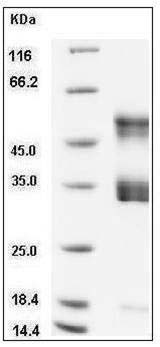-
Product Name
Human Urokinase/PLAU (His Tag) recombinant protein
- Documents
-
Description
Plasminogen activator, urokinase, also known as PLAU and uPA, is a serine protease which converts plasminogen to plasmin, a broad-spectrum protease active on extracellular matrix (ECM) components. It is involved in complement activation, cell migration, wound healing, and generation of localized extracellular proteolysis during tissue remodelling, pro-hormone conversion, carcinogenesis and neoplasia. Like many components of the blood coagulation, fibrinolytic and complement cascades, uPA has a modular structure, including three conserved domains: a growth factor-like domain (GFD, residues 1-49), a kringle domain (residues 50-131), linked by an interdomain linker or "connecting peptide" (CP, residues 132-158) to the serine protease domain (residues 159-411). uPA and its receptor (uPAR) have been implicated in a broad spectrum of pathophysiological processes, including fibrinolysis, proteolysis, inflammation, atherogenesis and plaque destabilization, all of which are involved in the pathogenesis of MI (myocardial infarction). The role of uPA is not only linked to its action as an enzyme. In fact, the mere binding of uPA on the cell surface also brings about two events that broaden the spectrum of its biological functions: (1) a conformational change of the receptor, which, in turn, affects its interaction with other proteins; (2) a signal transduction which modulates the expression of apoptosis-related genes. Besides its applications as a thrombolytic agent and as a prognostic marker for tumors, uPA may provide the basis for other therapies, as the structure of the receptor-binding domain of uPA has become a model for the design of anti-cancer molecules. Because of the causal involvment of uPA in cancer invasion and metastasis, the blockade of uPA interactions and activity with specific inhibitors is of interest for novel strategies in cancer therapy.
-
Protein name
Plasminogen activator, urokinase, isoform CRA_a
-
Protein short names
ATF; BDPLT5; URK; QPD; UPA; PLAU; U-PA
-
Uniprot ID
Q59GZ8
-
Gene Name
PLAU; hCG_20537
-
Source/Expression Host
Human Cells
-
Expression Plasmid/cDNA
A DNA sequence encoding the human PLAU (NP_002649.1) (Met 1-Leu 431) with a C-terminal polyhistidine tag was expressed. The purified protein was activated by trypsin in vitro.
-
Protein Species
Human
-
Molecular weight
The secreted recombinant human PLAU comprises 422 amino acids with a predicted molecular mass of 46 kDa. As a result of glycosylation and cleavage, rhPLAU migrates as three bands corresponding to the long ? chain, ? chain and unprocessed full-length PLAU with the molecular mass of 18, 32 and 50 kDa respectively in SDS-PAGE under reducing conditions.
-
Purity
> 97 % as determined by SDS-PAGE
-
Activity
Measured by its ability to cleave a peptide substrate, N-carbobenzyloxy-Gly-Gly-Arg-7-amido-4-methylcoumarin (Z-GGR-AMC). The specific activity is >2000 pmoles/min/μg.
-
Validations

Human Urokinase / PLAU (activated by trypsin) Protein (His Tag) SDS-PAGE
Related Products / Services
Please note: All products are "FOR RESEARCH USE ONLY AND ARE NOT INTENDED FOR DIAGNOSTIC OR THERAPEUTIC USE"
